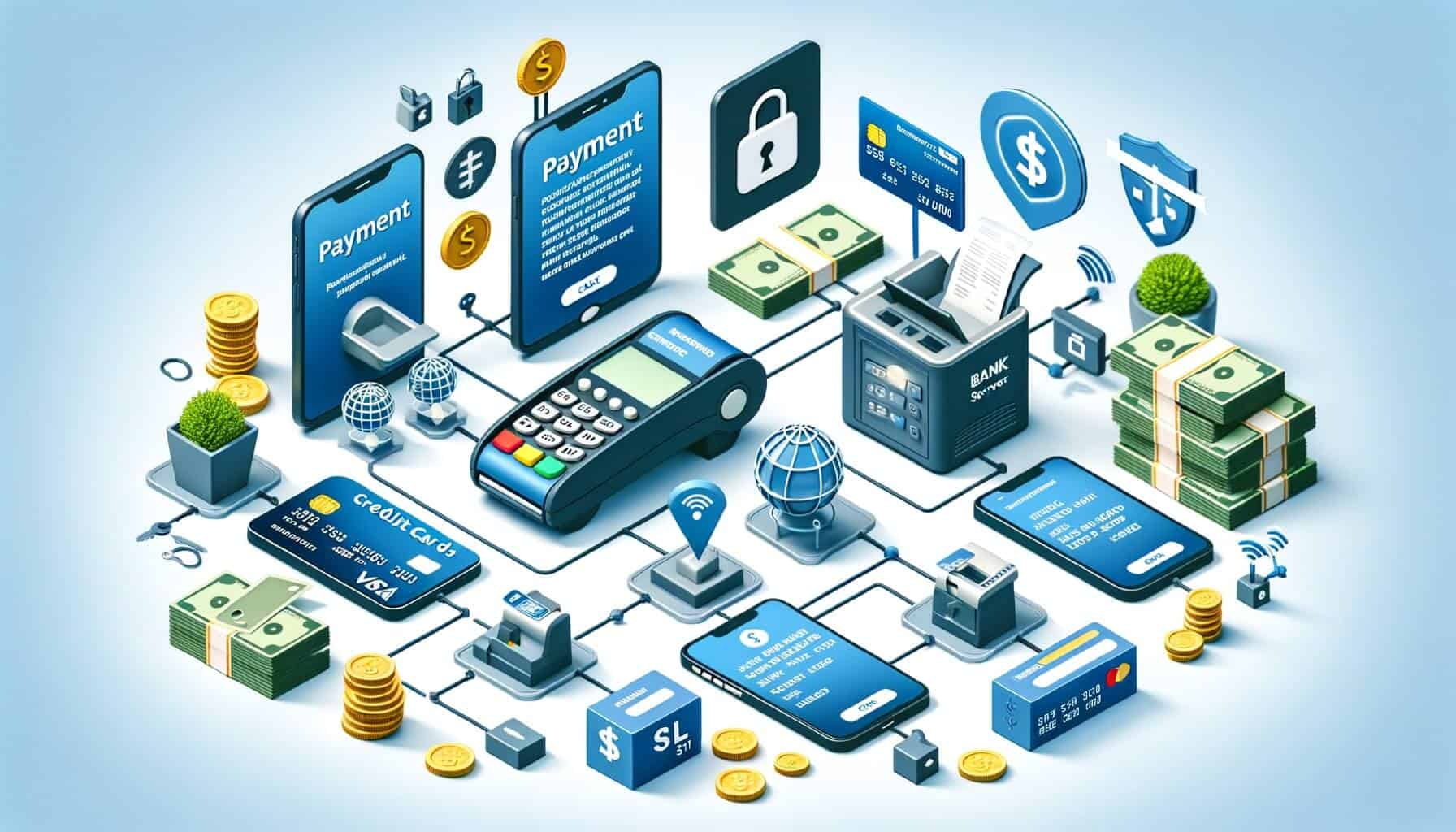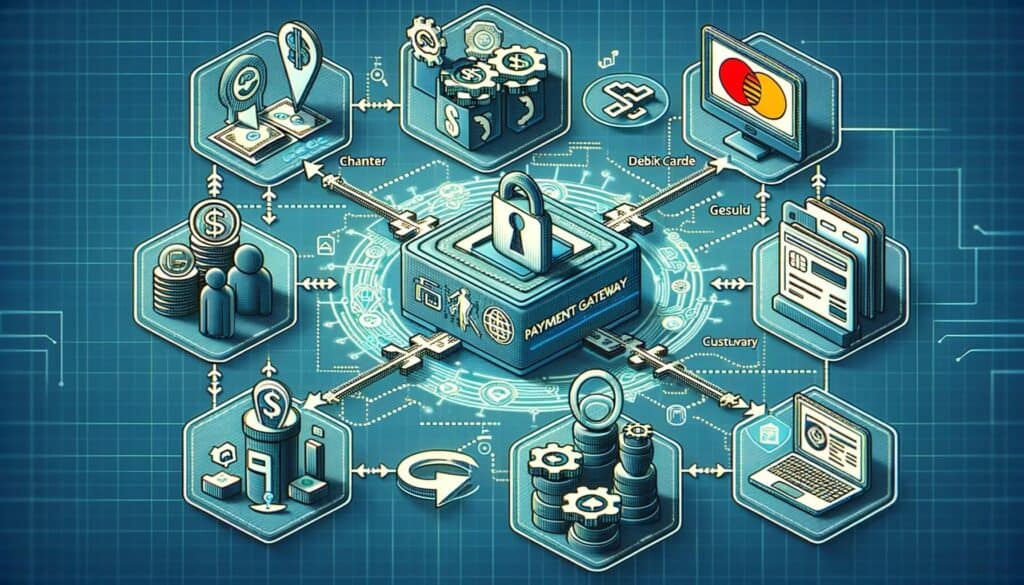
By Mollie Mills January 27, 2025
Payment processing is an essential aspect of any business that involves accepting payments from customers. Whether you run a brick-and-mortar store or an online business, understanding how payment processing works is crucial for ensuring smooth transactions and customer satisfaction. In this comprehensive guide, we will delve into the intricacies of payment processing, covering everything from the payment ecosystem to security measures and integration into e-commerce platforms.
Understanding the Payment Processing Ecosystem
The payment processing ecosystem consists of various entities that work together to facilitate the movement of funds from the customer to the merchant. These entities include the customer, the merchant, the payment processor, the payment gateway, and the acquiring bank. Let’s take a closer look at each of these components:
1. Customer: The customer is the individual or entity making a purchase and initiating the payment process. They can use various payment methods, such as credit cards, debit cards, digital wallets, or bank transfers.
2. Merchant: The merchant is the business or individual selling goods or services and receiving payments from customers. They need to have a merchant account with an acquiring bank to accept payments.
3. Payment Processor: The payment processor acts as an intermediary between the merchant and the acquiring bank. They handle the technical aspects of processing payments, including authorization, settlement, and reporting.
4. Payment Gateway: The payment gateway is a secure platform that connects the merchant’s website or point-of-sale system to the payment processor. It encrypts sensitive payment data and facilitates the transmission of information between the customer, merchant, and payment processor.
5. Acquiring Bank: The acquiring bank is responsible for processing the funds received from the customer’s bank and depositing them into the merchant’s account. They also manage chargebacks and provide customer support for payment-related issues.
Types of Payment Methods and their Functionality

Payment methods have evolved significantly over the years, offering customers a wide range of options to choose from. Let’s explore some of the most common payment methods and their functionality:
1. Credit Cards: Credit cards are one of the most popular payment methods worldwide. Customers can make purchases using their credit card details, and the payment processor verifies the transaction with the card issuer before approving it. Credit cards offer convenience and flexibility to customers, but they also come with interest rates and potential debt.
2. Debit Cards: Debit cards are linked to the customer’s bank account, allowing them to make purchases using the available funds. The payment processor verifies the transaction with the card issuer and deducts the amount from the customer’s account. Debit cards offer a convenient way to pay without the risk of accumulating debt.
3. Digital Wallets: Digital wallets, also known as e-wallets, are virtual accounts that store payment information securely. Customers can link their credit cards, debit cards, or bank accounts to their digital wallet and make payments by simply entering their login credentials. Popular digital wallets include PayPal, Apple Pay, Google Pay, and Samsung Pay.
4. Bank Transfers: Bank transfers involve the direct transfer of funds from the customer’s bank account to the merchant’s account. Customers can initiate bank transfers through online banking platforms or by visiting their bank branch. Bank transfers are a secure payment method but may take longer to process compared to other methods.
5. Cryptocurrencies: Cryptocurrencies, such as Bitcoin and Ethereum, have gained popularity as a decentralized and secure payment method. Customers can make payments using their cryptocurrency wallets, and the transactions are verified by a network of computers known as miners. Cryptocurrencies offer anonymity and lower transaction fees but are still not widely accepted by merchants.
The Role of Payment Gateways in Processing Transactions

Payment gateways play a crucial role in processing transactions securely and efficiently. They act as a bridge between the merchant’s website or point-of-sale system and the payment processor. Here are some key functions of payment gateways:
1. Encryption and Security: Payment gateways encrypt sensitive payment data, such as credit card numbers, to protect it from unauthorized access. They use secure socket layer (SSL) encryption, which ensures that the data transmitted between the customer, merchant, and payment processor remains confidential.
2. Payment Data Transmission: Payment gateways facilitate the transmission of payment data between the customer, merchant, and payment processor. They ensure that the information is accurately transmitted and received, allowing for seamless transaction processing.
3. Payment Method Integration: Payment gateways support various payment methods, allowing customers to choose their preferred option. They integrate with different payment processors and acquiring banks to ensure compatibility with the merchant’s chosen payment ecosystem.
4. Fraud Prevention: Payment gateways employ advanced fraud prevention measures to protect merchants and customers from fraudulent transactions. They use algorithms and machine learning to detect suspicious activities and flag potentially fraudulent transactions for further investigation.
5. Reporting and Analytics: Payment gateways provide merchants with detailed reports and analytics on their transactions. This information helps merchants track sales, identify trends, and make informed business decisions.
Step-by-Step Guide to the Payment Processing Workflow
The payment processing workflow involves several steps, from the initiation of the payment to the settlement of funds. Let’s walk through the typical payment processing workflow:
1. Customer Initiates Payment: The customer selects their desired products or services and proceeds to the checkout page. They choose their preferred payment method, such as a credit card or digital wallet, and enter the necessary payment details.
2. Payment Data Encryption: The payment gateway encrypts the customer’s payment data to ensure its security during transmission. This encryption process converts the sensitive information into an unreadable format, making it virtually impossible for hackers to decipher.
3. Authorization Request: The payment gateway sends an authorization request to the payment processor, along with the encrypted payment data. The payment processor forwards the request to the card issuer or the customer’s bank for verification.
4. Authorization Response: The card issuer or the customer’s bank receives the authorization request and verifies the customer’s payment details, such as available funds or credit limit. They send an authorization response back to the payment processor, indicating whether the transaction is approved or declined.
5. Transaction Approval: If the authorization response is positive, the payment processor sends an approval message to the payment gateway. The payment gateway then notifies the merchant that the transaction has been approved, allowing them to proceed with order fulfillment.
6. Settlement and Funds Transfer: Once the transaction is approved, the payment processor initiates the settlement process. They transfer the funds from the customer’s bank account or credit card to the acquiring bank. The acquiring bank then deposits the funds into the merchant’s account, usually within a few business days.
7. Transaction Confirmation: The payment gateway sends a transaction confirmation to the merchant, indicating that the funds have been successfully transferred. The merchant can now fulfill the order and provide the customer with the purchased goods or services.
Security Measures and Fraud Prevention in Payment Processing

Security is a top priority in payment processing, as it involves the transmission and storage of sensitive customer data. Payment processors, payment gateways, and merchants implement various security measures to protect against fraud and data breaches. Here are some common security measures and fraud prevention techniques:
1. PCI DSS Compliance: The Payment Card Industry Data Security Standard (PCI DSS) is a set of security standards established by major card networks, such as Visa, Mastercard, and American Express. Merchants and payment processors must comply with these standards to ensure the secure handling of cardholder data.
2. Tokenization: Tokenization is a process that replaces sensitive payment data, such as credit card numbers, with unique tokens. These tokens are meaningless to hackers and can be safely stored or transmitted without compromising the customer’s data.
3. Two-Factor Authentication: Two-factor authentication adds an extra layer of security by requiring customers to provide additional verification, such as a one-time password sent to their mobile device, in addition to their payment details. This helps prevent unauthorized access to customer accounts.
4. Address Verification System (AVS): AVS is a fraud prevention measure that compares the billing address provided by the customer with the address on file with the card issuer. If there is a mismatch, it may indicate a fraudulent transaction and trigger further investigation.
5. CVV/CVC Verification: The Card Verification Value (CVV) or Card Verification Code (CVC) is a three- or four-digit number printed on the back of credit cards. Merchants can request this code during the payment process to verify that the customer has physical possession of the card.
6. Fraud Detection Algorithms: Payment processors and payment gateways use sophisticated algorithms to detect patterns and anomalies that may indicate fraudulent activity. These algorithms analyze various factors, such as transaction amount, frequency, and location, to identify suspicious transactions.
7. Chargeback Management: Chargebacks occur when a customer disputes a transaction and requests a refund from their bank. Merchants must have effective chargeback management systems in place to handle these disputes and provide evidence of the transaction’s validity.
Payment Processing Fees and Costs Explained
Payment processing fees and costs can vary depending on the payment method, the merchant’s business model, and the chosen payment processor. It’s important for merchants to understand the different types of fees and costs associated with payment processing. Here are some common fees and costs explained:
1. Interchange Fees: Interchange fees are charged by the card networks, such as Visa and Mastercard, for processing credit and debit card transactions. These fees are typically a percentage of the transaction amount plus a flat fee. The exact interchange fee depends on factors such as the type of card used, the merchant’s industry, and the transaction volume.
2. Assessment Fees: Assessment fees are charged by the card networks to cover their operational costs and maintain the payment infrastructure. These fees are also a percentage of the transaction amount plus a flat fee. Merchants do not have control over assessment fees, as they are set by the card networks.
3. Payment Processor Fees: Payment processors charge fees for their services, including transaction processing, fraud prevention, and customer support. These fees can be a percentage of the transaction amount, a flat fee per transaction, or a combination of both. Payment processors may also charge additional fees for services such as chargeback management or recurring billing.
4. Monthly Fees: Some payment processors may charge monthly fees for access to their payment processing services. These fees can cover features such as reporting and analytics, integration with e-commerce platforms, or dedicated customer support. Monthly fees vary depending on the payment processor and the level of service required.
5. Cross-Border Fees: Cross-border fees apply when a customer makes a payment in a currency different from the merchant’s account currency. These fees cover the costs of currency conversion and international transaction processing. Cross-border fees are typically a percentage of the transaction amount plus a flat fee.
6. Chargeback Fees: Chargeback fees are charged by payment processors or acquiring banks when a customer disputes a transaction and initiates a chargeback. These fees cover the administrative costs associated with handling the dispute. Chargeback fees can vary depending on the payment processor and the number of chargebacks incurred.
Integrating Payment Processing into E-commerce Platforms
Integrating payment processing into e-commerce platforms is essential for online businesses to accept payments seamlessly. E-commerce platforms, such as Shopify, WooCommerce, and Magento, offer various integration options to connect with payment processors and payment gateways. Here’s a step-by-step guide to integrating payment processing into an e-commerce platform:
1. Choose an E-commerce Platform: Select an e-commerce platform that suits your business needs and budget. Consider factors such as ease of use, scalability, available features, and compatibility with your chosen payment processor.
2. Select a Payment Processor: Research and choose a payment processor that aligns with your business requirements. Consider factors such as transaction fees, supported payment methods, fraud prevention measures, and integration options with your chosen e-commerce platform.
3. Set up a Merchant Account: To accept payments, you need to set up a merchant account with an acquiring bank. The payment processor can assist you in this process, as they often have partnerships with acquiring banks. Provide the necessary documentation and complete the application process to open a merchant account.
4. Configure Payment Settings: In your e-commerce platform’s settings, navigate to the payment section and select your chosen payment processor. Enter the required credentials, such as API keys or merchant IDs, to establish the connection between your e-commerce platform and the payment processor.
5. Test the Integration: Before going live, it’s crucial to test the payment integration to ensure that everything is functioning correctly. Place test orders using different payment methods and verify that the transactions are processed successfully. Test various scenarios, such as successful transactions, declined transactions, and refunds, to ensure that your integration handles them appropriately.
6. Enable Security Measures: Implement additional security measures, such as SSL encryption and two-factor authentication, to protect customer data and prevent fraud. Enable fraud prevention settings provided by your payment processor to minimize the risk of fraudulent transactions.
7. Monitor and Optimize: Continuously monitor your payment processing performance and analyze transaction data to identify any issues or areas for improvement. Optimize your payment flow based on customer feedback and industry best practices to enhance the user experience and increase conversion rates.
Common Challenges and Troubleshooting in Payment Processing
Despite the advancements in payment processing technology, there are still common challenges that merchants may encounter. Let’s explore some of these challenges and how to troubleshoot them.
1. Payment Declines: Payment declines can occur for various reasons, such as insufficient funds, expired cards, or technical issues. To troubleshoot payment declines, merchants should ensure that the customer’s payment details are entered correctly, the card is not expired, and there are sufficient funds or credit limit available. If the issue persists, the customer should contact their bank or credit card issuer for further assistance.
2. Payment Gateway Integration Issues: Integrating a payment gateway with a merchant’s system can sometimes be challenging, especially for non-technical users. To troubleshoot integration issues, merchants should carefully follow the integration documentation provided by the payment gateway. If issues persist, contacting the payment gateway’s customer support team can help resolve any technical difficulties.
3. Chargebacks and Disputes: Chargebacks and disputes can be time-consuming and costly for merchants. To minimize the risk of chargebacks, merchants should provide clear product descriptions, accurate shipping information, and excellent customer service. In case of a chargeback, merchants should gather all relevant documentation, such as proof of delivery or customer communication, to support their case during the dispute resolution process.
4. Security and Compliance Concerns: Security and compliance are ongoing challenges in payment processing. Merchants should regularly update their systems and software to ensure they are protected against the latest security threats. Compliance with PCI DSS standards is crucial to maintain the security of cardholder data. Regular security audits and vulnerability assessments can help identify and address any potential security vulnerabilities.
FAQs
Q1. What is a payment processor?
A payment processor is a company or service that facilitates the transfer of funds from a customer to a merchant. It securely captures and transmits the customer’s payment information, verifies its validity, and transfers the funds from the customer’s account to the merchant’s account.
Q2. How long does it take for a payment to be processed?
The time it takes for a payment to be processed depends on various factors, such as the payment method used, the acquiring bank’s policies, and the merchant’s settlement schedule. In general, credit card payments are processed within a few seconds, while bank transfers may take a few business days to complete.
Q3. What is a payment gateway?
A payment gateway is a secure intermediary between the customer, the merchant, and the acquiring bank. It captures and encrypts the customer’s payment information, verifies its validity, and transmits it to the acquiring bank for authorization. The payment gateway also handles fraud detection and prevention, integration with merchant systems, and payment confirmation.
Q4. How can merchants protect against fraud in payment processing?
Merchants can protect against fraud by implementing various security measures, such as PCI DSS compliance, tokenization, two-factor authentication, and advanced fraud detection tools. Regular monitoring of transactions, analyzing patterns, and suspicious activity can help identify and prevent fraudulent transactions.
Q5. What are chargebacks, and how can merchants handle them?
Chargebacks occur when a customer disputes a transaction and requests a refund from their bank or credit card issuer. Merchants should provide clear product descriptions, accurate shipping information, and excellent customer service to minimize the risk of chargebacks. In case of a chargeback, merchants should gather all relevant documentation to support their case during the dispute resolution process.
Conclusion
Payment processing has come a long way, evolving from traditional cash transactions to digital payments and contactless technologies. As technology continues to advance, we can expect further innovations in payment processing, such as biometric authentication, blockchain-based transactions, and enhanced security measures.
The future of payment processing lies in providing seamless, secure, and convenient payment experiences for both merchants and customers. With the increasing adoption of mobile devices and digital wallets, we can anticipate a shift towards mobile payments and the integration of payment processing with other technologies, such as Internet of Things (IoT) devices and voice assistants.
As the payment processing ecosystem continues to evolve, merchants must stay updated with the latest trends, technologies, and security measures to ensure a smooth and secure payment experience for their customers. By understanding the intricacies of payment processing and implementing best practices, merchants can optimize their payment workflows, minimize risks, and provide a seamless payment experience that fosters customer trust and loyalty.